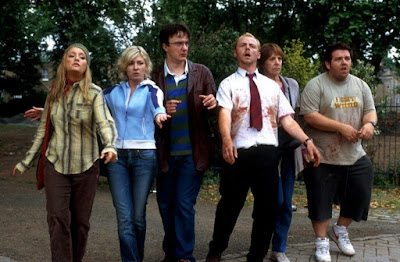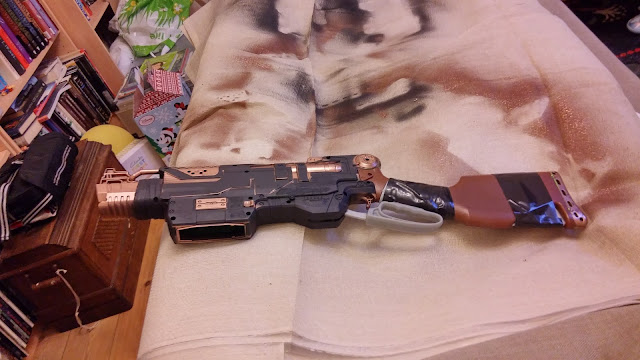 |
| In the intervening twenty years, the Sectoids got ripped. |
Somewhat behind the rest of the world, I'f started playing
X-COM 2. Here are my early thoughts. As a note, I picked up a copy with plenty of DLC, including 'Shen's Final Gift', in which you discover a robot soldier left for you by Dr Shen, and 'Alien Hunters', in which you find some Van Helsing type weapons in a downed Skyranger and a major headache left for you by Dr Vahlen.
You open in a world governed by ADVENT, an alien backed government that decries X-COM as terrorists. Taking initial control of the traditional tutorial sacrifices, you bring your team along with Central Officer Bradford, to extract the Commander - who, in a metafictional headfuck, is of course
you - from an ADVENT facility where - to continue the headfuckery - you have spent decades unwittingly aiding the aliens by playing through endless variations of the invasion in a simulation in your mind, which is implied to have been the original
X-COM reboot.
 |
| Make no mistake; officer pullover will fuck you up. |
This game is based around the
Avenger, a captured alien transport fixed up by the now-vanished Dr Shen and his badass daughter Lily. It has its own engineering section and labs - run by former ADVENT collaborator Dr Tygan - a geoscape, and an 'ant farm' where you can build your facilities after clearing out the junk.
Much of the game is the same as it ever was, but with the addition of an overworld map which you need to navigate by contacting resistance cells, scanning locations and slowly expanding your influence. Some of your missions come from the resistance, others from scanning intel points, and some are linked to the central goal of preventing a project called Avatar reaching fruition by attacking alien facilities. The main things to get to grips with in the overworld are that funding is hella slow, scientists and engineers are rarer than hen's teeth, and you
will miss out on things because there simply isn't time to do everything. Every time you set down to scan for supplies, there's a good chance one of your resistance bases will get raided, requiring you to mount a rescue mission (the game's equivalent of the old terror missions,) in which you have to tag out as many civilians as possible, at least one of whom is a shapeshifting ooze-ogre called a Faceless.
 |
| The more things change, the more they stay the same. |
The mission control system is reassuringly familiar, as you order your troops across an isometric landscape, juggling unit cohesion with sightlines, cover and the need to shoot as many things as much as possible, because the aliens are much, much tougher this time out. Basic Sectoids are nails hard and chuck around mind control from mission 1. The Thin Men are replaced by the Viper, a vaguely feminine snake with arms, guns and an attitude problem. Even the grunts - adapted human troopers - have wicked pulse rifles and are led by tough officers with a fierce scarf game. Later on you start running into armoured opponents and shit gets real.
The other big difference is that you start most missions Concealed, until you get spotted or take a shot, which means that you can sneak up and ambush the first set of aliens by setting up lots of Overwatch before you spook them, and there is little in gaming more satisfying than pulling off a perfect opening ambush. There are also plenty of minor changes to the system: In particular, reloading no longer ends your turn, so if you run dry in a protracted fight you can spend your next turn by reloading and
then firing. You can also call in an evac if the mission goes south, and carry your fallen comrades home for life-saving treatment or to nick their stuff. Weapons are upgraded at a squad level (unlock the shard gun and all your shotguns become shard guns) but can individually be fitted with modular upgrades like stocks, sights and hair-triggers captured from dead enemies to give a nice, piecemeal feeling to the loadout.
 |
| "We'll include all the old alien types, but unrecognisable and really nasty." |
There is a slight change to the class system: Rangers replace the old Assault class, largely by bringing a knife to the gunfight, although when I say knife I mean machete and when I say gunfight I mean it would have been a gunfight if the other guy had a face left. Heavies are now Grenadiers, swapping their rockets for a grenade launcher. Snipers are Sharpshooters, and Supports are replaced by the Specialist, who has a hovering drone. Progression follows the same two-stream system, with mixing and matching perfectly possible, but the themes are much stronger. Grenadiers essentially get machine gun or grenade upgrades, Sharpshooters rifle or pistol, Rangers stealth or stabbing, and Specialists medical or 'combat hacker', which provides a suite of offensive and technical abilities. All troops are also super-customisable, although I'm not even touching that yet.
 |
| "You're very tall." |
More variety is provided by the DLC. 'Shen's Final Gift' is a marathon slog through a robot factory filled with killer robots, controlled by an AI named Julian. Survive the bots and the turrets and the poison gas and you get to fight Julian on the roof, in control of a particularly vicious Sectopod, for control of Spark-001, a robot battle chassis. I called him 'Reus' for reasons which will likely elude those not au fait with the requirements of criminal culpability and/or Latin, and also HALO. It's a slog, and Sectopod Julian is a bugger, especially if you go at it in the early game (which I did.) On the plus side, your Specialist for the mission is Lily Shen, who is a tricked out Combat Hacker (and instant fail condition if she gets killed.) She is also, it turns out, Dr Shen's Final Gift, but in gameplay terms we get to keep the Spark.
 |
| VAHLEN!!! |
And at least Shen left us something useful (as well as a crazy AI.) 'Alien Hunters' give you a set of special weapons - the Bolt Caster, a powerful but single shot rifle; the Shadowkeeper, a kick ass pistol which can drop you back into Concealment once per mission; and the Hunter's Axe, an awesome melee weapon with a second axe for throwing - and another new mission, this time to track down traces of Dr Vahlen, who turns out to have left you... a trio of giant 'ruler' monsters with dozens of hitpoints each,
and armour,
and they not only get a move during the alien turn, but after
every one of your actions. And then if you ding them up a bit they run away, and randomly appear in another mission. If you're really lucky, you'll meet the Berserker Queen in a time-critical mission which then becomes impossible because you spent four turns trying not to get stepped on. On the plus side, in the initial mission you get to take Bradford along, although that does have the downside that, as a max-level Ranger with a custome assault rifle, he tends to hog between most of and
all of the kills.
 |
| The Codex is basically Norton Antivirus with an actual gun. |
X-COM 2 takes the excellence of
X-COM: Enemy Unknown and runs with it, providing tougher challenges and an entirely new level of conflict to consider in the form of the overworld map, as well as sexier graphics and an almost entirely absent tendency for troops to appear to be shooting in entirely the wrong direction in the cut scenes. The limited resources enhance the resistance feel of the game, and it is very possible for an otherwise perfect mission - of which I have so far had
one - to go aggressively south with the addition of a roving ruler or unexpected Codex (a flickering extra-dimensional projection of the ADVENT internet.) You are likely to spend a lot of time shuffling between troops with 60% of your force in the infirmary at any one time, especially while you're still using kevlar armour. Moreover, wounded soldiers can become Shaken, rendering them prone to panic and mind-control until they come through a mission effective and unscathed. Thus you have equal and opposite incentives to bench shaken troops or to bring them with.
There's only one real problem with the game, and that is that it kind of spoils its predecessor. I've played a lot of
X-COM over the last couple of years, but I'm not sure I'll go back to it now that it's just a simulation I played in my head while I was in a tank, so that the aliens could learn to beat my peeps in battle. It's like being... the anti-Ender, which is depressing, if probably free of ultra-right bias at least.


























